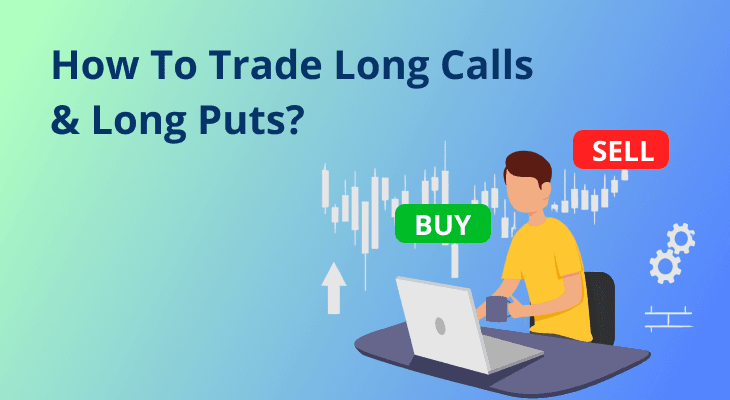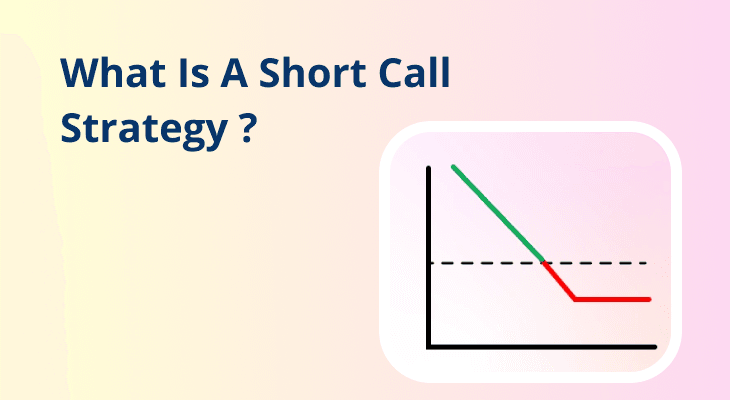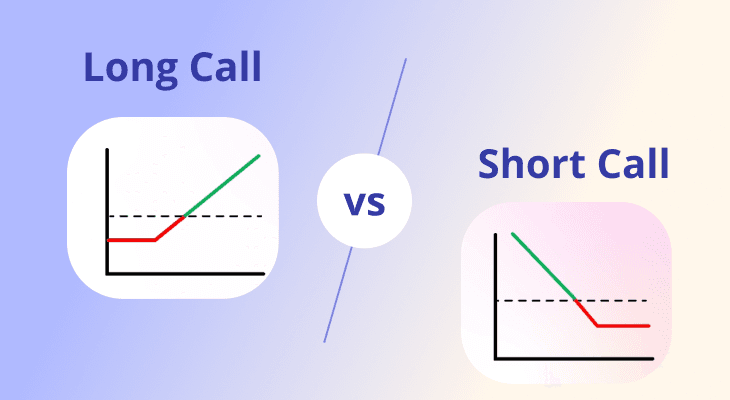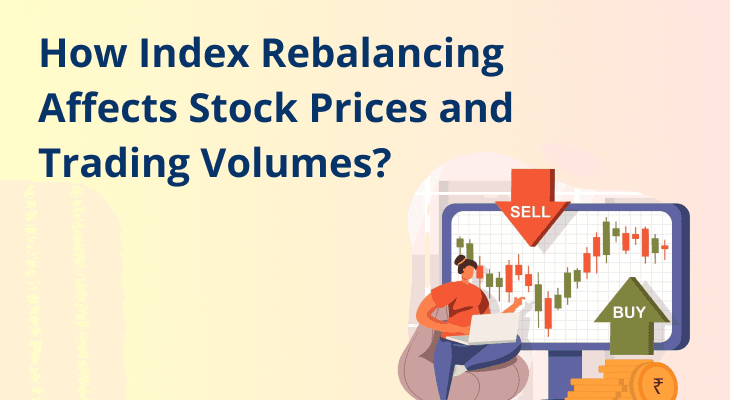
How To Trade Long Calls & Long Puts?
For investors looking to explore options trading, two foundational strategies often come up early in the learning curve: the long call and the long put. These strategies allow you to benefit from directional movements in a stock or index with limited capital and defined risk. However, understanding how and when to use each is crucial before placing a trade.
This guide will walk you through what long call and long put options are, how they work, how they differ from one another, and how to actually trade them as part of your investment arsenal.
Introduction To Options Trading
Before getting into the intricacies of long put and long call options, let us understand what options trading is.
Options are derivative contracts that give the buyer the right, but not the obligation, to buy or sell an underlying asset at a predetermined price within a specific time period. These contracts come in two basic types:
- Call Options: Give you the right to buy the underlying asset.
- Put Options: Give you the right to sell the underlying asset.
When you buy options (either calls or puts), you’re taking a "long" position in those contracts. The opposite, selling or writing them, creates a "short" position.
What Is A Long Call Option?
A long call option is a bullish strategy. When you expect the price of a stock to go up significantly, buying a call option allows you to profit from that move without purchasing the stock itself.
Characteristics Of Long Call:
- Right to Buy: The buyer has the right to buy the underlying stock at the strike price.
- Premium Paid: You pay a premium upfront to enter the contract.
- Limited Loss, Unlimited Upside: Your maximum loss is limited to the premium paid. Your profit potential is theoretically unlimited if the stock rises significantly.
When To Use A Long Call Strategy:
- When you're bullish on a stock’s future price.
- When you want to limit your downside but benefit from upward movement.
- When you prefer leverage instead of buying the stock directly.
Example With Calculation:
Suppose you buy a call option on Stock A:
- Strike Price: ₹100
- Premium Paid: ₹5
- Lot Size: 100 shares
- Break-Even Price: ₹105 (Strike + Premium)
If Stock A moves to ₹115 before expiry, you can exercise the option:
- Profit = ((115 - 100) - 5) × 100 = ₹1,000
If Stock A stays below ₹100:
- Loss = ₹5 × 100 = ₹500 (the premium paid to buy the option)
Pros Of Long Call Options
- Limited Risk, Unlimited Upside: The maximum loss is capped at the premium paid, but the potential profit is unlimited if the stock rises.
- Leverage: Traders can gain exposure to large price movements by investing a small premium amount.
- Ideal for Bullish Outlooks: Suited for traders expecting a strong upward price move in the underlying asset.
- No Obligation to Exercise: If the trade doesn’t go in your favor, you can let the option expire and limit your loss.
Risks/Limitations Of Long Call Options
- Time Decay: The value of a call option decreases as it approaches expiry if the price doesn’t move in the trader’s favour.
- Premium Loss: If the stock doesn’t move above the strike price, the entire premium is lost.
- Requires Accurate Timing: Even if the asset eventually rises, the move must occur within the option’s expiry period.
- Lower Probability of Profit: Compared to short strategies, long options often require larger moves to become profitable.
What Is A Long Put Option?
A long put option is a bearish strategy. It gives the buyer the right to sell the underlying stock at the strike price. It is used when you expect the stock’s price to decline.
Characteristics Of Long Put:
- Right to Sell: You can sell the stock at the strike price.
- Premium Paid: Just like a call, you pay an upfront premium.
- Limited Loss, Large Gain Potential: You risk only the premium but gain if the stock falls below the strike.
When To Use A Long Put Strategy:
- When you expect the stock to drop significantly.
- To hedge your portfolio or long stock holdings.
- When short-selling is not preferred or allowed.
Example With Calculation:
You buy a put on Stock B:
- Strike Price: ₹200
- Premium Paid: ₹10
- Lot Size: 100 shares
- Break-Even: ₹190 (Strike - Premium)
If Stock B drops to ₹170, you can exercise the option:
- Profit = (200 - 170 - 10) × 100 = ₹2,000
If it stays above ₹ 200, you lose the premium paid:
- Loss = ₹ 10 × 100 = ₹1,000
Pros Of Long Put Options
- Profit from Downward Movement: Allows traders to benefit from falling stock prices without shorting the stock.
- Limited Losses: The maximum loss is limited to the premium paid, providing defined risk.
- Leverage in Bearish Trends: Enables participation in bearish trades with lower capital investment.
- Hedging Tool: Can be used to hedge long positions and protect against downside risk.
Risks/Limitations Of Long Put Options
- Time-Sensitive: Like call options, long puts lose value over time, especially as expiry nears.
- Premium Can Become a Total Loss: If the underlying stock doesn't fall below the strike price, the entire premium is lost.
- Volatility Dependency: High implied volatility increases premiums, which can reduce profitability.
- Requires Strong Downward Move: Small price drops may not cover the premium, making the trade unprofitable.
Summary Table: Key Differences Between Long Call and Long Put
Feature | Long Call | Long Put |
|---|---|---|
Market View | Bullish | Bearish |
Right to | Buy | Sell |
Maximum Loss | Premium paid | Premium paid |
Maximum Gain | Unlimited | Strike price less Premium paid. |
Break-Even Point | Strike + Premium | Strike – Premium |
Use Case | Expect stock price to rise | Expect stock price to fall |
How To Trade Long Calls & Puts (Step-by-Step)
Whether you're choosing a long call or long put strategy, follow these steps to structure a smart, well-planned trade:
Step 1: Select Your View
Decide if you're bullish or bearish. This determines whether to go for a call or a put.
Step 2: Pick the Right Stock and Expiry
Choose a stock with momentum or trend potential. Also select an expiry date that gives the trade enough time to work.
Step 3: Choose a Strike Price
- In-the-Money (ITM): More expensive but higher chances of success.
- At-the-Money (ATM): Balanced premium and risk.
- Out-of-the-Money (OTM): Cheaper, but more speculative.
Step 4: Calculate Your Break-Even and Risk-Reward
Always know your break-even point and how much you stand to gain or lose.
Step 5: Monitor and Exit
Track the movement in the underlying stock and exit before expiry if your target is achieved or if your view changes.
Common Mistakes To Avoid
- Ignoring Time Decay: Options lose value over time, especially close to expiry.
- Choosing Far OTM Options: They may seem cheap but are less likely to become profitable.
- Poor Timing: Buying a call or put without confirmation of trend can lead to losses.
- Not Using Stop-Loss: Always define exit points to protect capital.
- No Exit Strategy: Having a plan to exit is as important as entry.
Conclusion
Trading long calls and long puts can be a powerful way to participate in market movements with limited capital and predefined risk. While long calls profit from bullish moves, long puts offer an effective way to hedge or bet on market declines. But both require a clear understanding of timing, strike selection, and risk management.
When used wisely, these strategies can complement a broader investment or trading strategy, especially for retail traders looking to learn derivatives in a responsible way.
Additional Read: What Are Call and Put Options? How Do They Work?
FAQ
What is a long call option in simple terms?
A long call option gives you the right to buy a stock at a fixed price in the future. You use it when you think the stock's price will go up. If the price rises above your break-even, you can profit.
When should I use a long put option?
Use a long put when you expect a stock’s price to fall. It gives you the right to sell the stock at a set price. This strategy helps you earn from a falling market without needing to short-sell the stock.
What is the maximum loss in a long call or long put?
The maximum loss in both long call and long put is the premium you pay upfront. If the stock doesn't move in the direction you expected, your total loss is limited to this premium.
Can I trade long calls and puts with a small capital?
Yes. Options provide leverage, allowing you to control a larger stock position with a relatively small premium. This makes them accessible to investors with limited funds.
How do I calculate the break-even point in options?
For a long call, it’s the strike price plus the premium paid. For a long put, it’s the strike price minus the premium paid. Your trade becomes profitable only after crossing this point.
Are long puts good for hedging?
Yes. Long puts are commonly used to protect portfolios during falling markets. If your stock drops in value, the gains from the long put can offset your losses.
How long should I hold a long call or put option?
It depends on your target and expiry. Many traders exit when they reach a certain profit or if the market starts moving against them. Time decay accelerates near expiry, so holding too long can reduce returns.
What are in-the-money and out-of-the-money options?
In-the-money options have intrinsic value. For calls, this means the stock price is above the strike. For puts, the stock is below the strike. Out-of-the-money options are cheaper but require bigger moves to become profitable.
Can I lose more than my premium in long options?
No. Unlike short strategies, long call and long put trades have limited risk. The maximum loss is the premium paid, regardless of how much the stock moves against your view.
How is trading long puts different from short calls?
A long put gives you the right to sell and limits your loss to the premium. A short call is riskier, with unlimited loss potential if the stock rises. Beginners should avoid short calls unless they fully understand the risks.


